FORAGING FOR RAMPS
With John Wright’s Jim Switzenberg
PAPER ARTIST
Edward Babiarz
OUTDOOR
LIVING & GARDENS
Mediterranean Inspiration

With John Wright’s Jim Switzenberg
Edward Babiarz
LIVING & GARDENS
Mediterranean Inspiration

With
Favorite Neurologist





I have always had the mindset that I wanted to help others. As a youth, I was influenced by several skilled physicians and also my mother who worked as a nurse. I believe this led me to study medicine.
My decision to pursue neurology was triggered by an unfortunate event in my life, my grandfather’s stroke. I dedicated myself to learn about the human brain and was struck by how complicated it was but I never back down from a challenge.
I have a deep understanding of the feeling of helplessness a patient and family can experience when dealing with a neurological disorder. My goal is to help my patients and their loved ones navigate through this confusing and scary time to come up with a successful plan to improve their lives.
Fortunately, I have been well trained which has allowed me to be able to offer a variety of services to my patients ranging from medical management to procedures such as


MS
Botox, EEG, and EMG. I also am fortunate to work with our diverse group of dedicated physicians and staff that can offer neurological, neurosurgical, and pain management care all under one roof.
To reach Dr. John, or for more information on Argires Marotti Neurological Associates of Lancaster, visit their website at https://www.argiresmarotti.com or call (717) 358-0800.
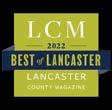
“I HAVE ALWAYS had the mindset that I wanted to help others.”

FROM BIRTHDAY CELEBRATIONS TO DATE NIGHTS to family dinners, Lombardo’s is a place to toast to life’s most meaningful moments. Serving up authentic Italian staples, sophisticated entrées, and delectable desserts, their team puts a lot of love into each dish. The freshest ingredients are chopped, mixed, and simmered to perfection, creating a vibrant collection of flavors so fragrant you’ll want to savor each bite. Pull up a chair and raise a glass—the table is set for you.
Check our website for hours and to make a reservation. lombardosrestaurant.com
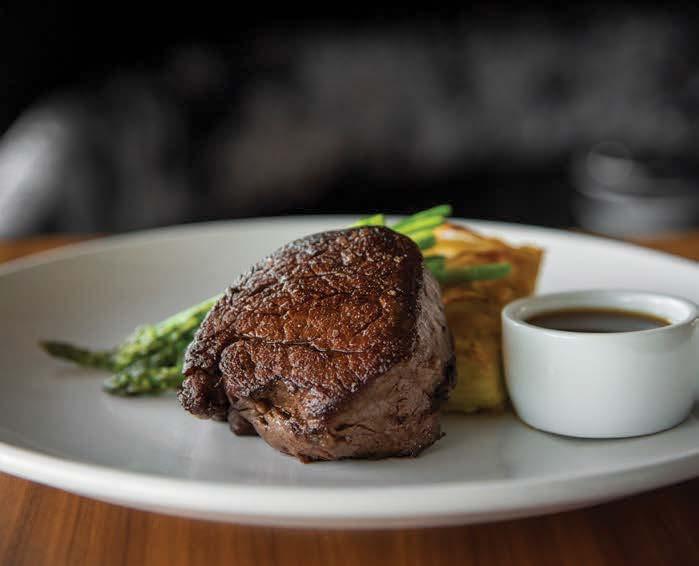
216 Harrisburg Avenue, Lancaster, PA 17603 717.394.3749
Let’s
PUBLISHER Jocelyn Engle
EDITOR
Suzanne Starling-Long Sue@lancastercountymag.com
ART DIRECTOR Ashley Kendrick Kennedy Ashley@lancastercountymag.com
ASSISTANT EDITOR
Kaylee Rex Kaylee@lancastercountymag.com
MARKETING DIRECTOR
Rachel Stebbins Rstebbins@engleonline.com

REGULAR CONTRIBUTORS
WRITERS
Dr. Richard L. Bitner Jill Brown
Rochelle A. Shenk
Michael C. Upton
Kathleen Wagner
PHOTOGRAPHERS
Jordan Bush
Nick Gould
Kirk Zutell
ADVERTISING INFORMATION
717-492-2525
SALES MANAGER

Greg March Gmarch@engleonline.com
ACCOUNT REPRESENTATIVES
Karen Stoltzfus Karen@lancastercountymag.com
PRODUCED & PUBLISHED BY Engle Printing & Publishing Co., Inc.
PROUD MEMBER OF:
Lancaster County Magazine is published monthly. Statements and opinions are the responsibility of the authors alone and do not imply an opinion on the part of Lancaster County Magazine Materials are copyrighted and may not be reproduced without written permission from the publisher. Suggestions welcome. Single copy price $2.95 (discounts available on quantity orders). Subscription price is $16.95 for 12 issues. Use address below.

Lancaster County Magazine P.O. Box 500 Mount Joy, PA 17552 Lancastercountymag.com
FOR SUBSCRIPTION INFO: 717-492-2556
@LancCountyMag

“The first thing I want my patients to know is that I am there for them. I can guarantee that.”
- Lori, RN Professional Care Manager
Jordan Bush employed his quadcopter to capture photos of Lancaster from above. The cover shot was taken in the Ronks area, where the pioneering Ferree family, who arrived in the Paradise area in 1712, came to own large swaths of farmland. Today, that farmland is cultivated by English and Plain farmers. One such farm, Cherry Crest Adventure Farm, has become a leader in agritainment.
Photographed August 29, 2022
Jordan Bush put his quadcopter to use and provided validation that Lancaster is “green” in unique ways. See how preservation, restoration, adaptive reuse, natural spaces and new aspects of tourism – agritainment and ecotourism – are adding to the allure of Lancaster County.
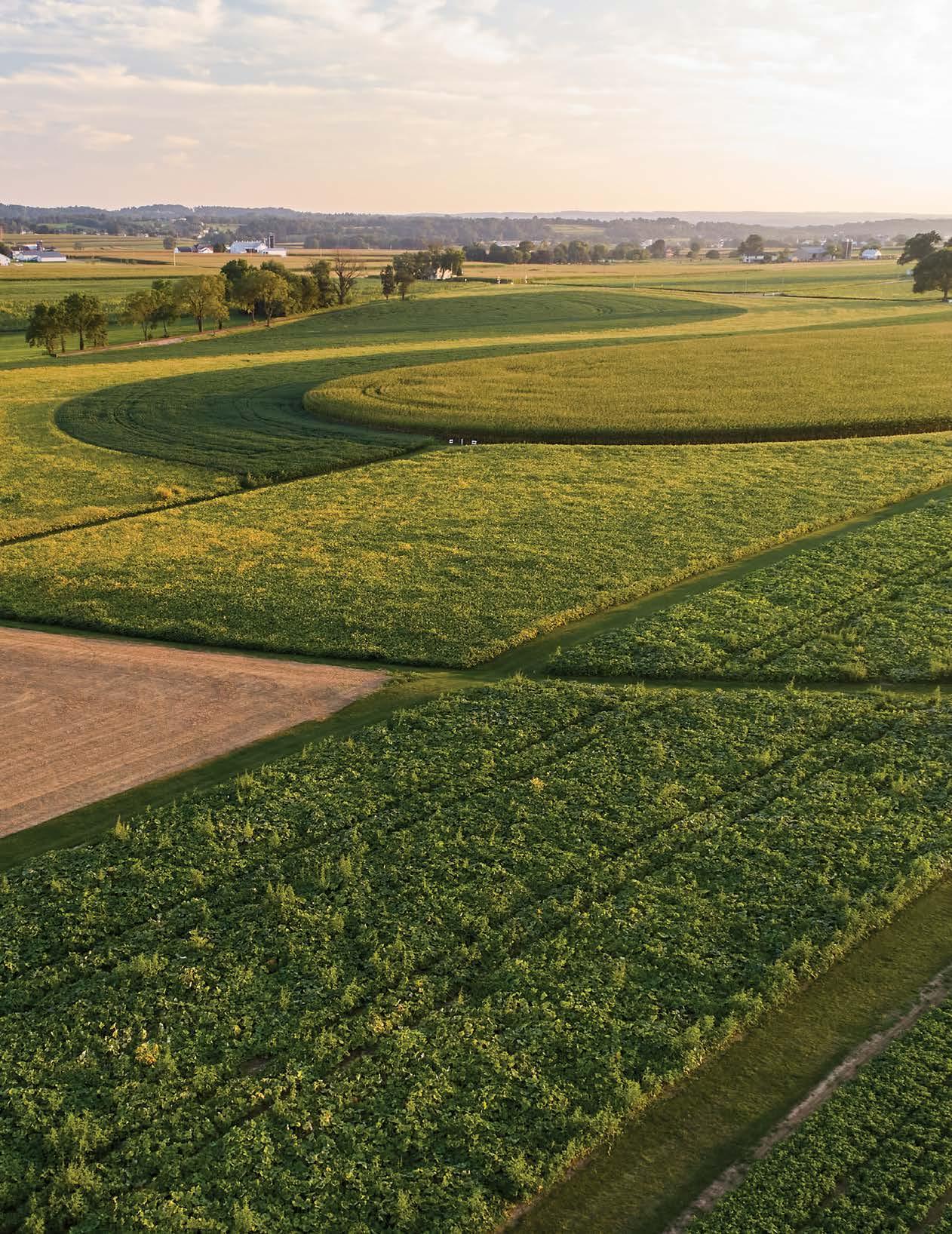
Michael Upton profiles Edward Babiarz, a paper artist whose work is currently on view at the Yocum Institute for Arts Education’s Holleran Gallery in Reading.
Last season, Europeans discovered that Mediterranean-style gardening and outdoor living provides a solution to dealing with climate change. This year the trend is making its way across “the pond” and is predicted to be the buzzword in American gardens. Dr. Richard Bitner explains the hows and whys of creating your own Mediterranean-influenced backyard getaway.
Jordan Bush joins Jim Switzenberg, the owner and executive chef at the John Wright Restaurant, to forage for ramps, a delicacy in the Appalachian region that heralds the arrival of spring and provides the ingredient for many fundraising dinners and festivals.
Meet author Jessica Whipple, who will be launching her first children’s book, Enough Is …, at Aaron’s Books in Lititz, on April 16.
Live music, theatre, art gallery and museum exhibits, craft/maker shows, outdoor activities and fundraising events are back on the calendar. Visit our website, lancastercountymag.com, to make plans and order tickets for upcoming events.
The businesses seen in this special advertising section are ready to help you welcome spring, whether it’s remodeling your home, creating an entertaining backyard, improving curb appeal, venturing out to local restaurants or seeing the sights.
Donald and Vivian Doolittle moved to Willow Valley Communities to experience the exceptional lifestyle our residents have been enjoying for nearly 40 years. “We experience more of what we love without thinking about the details,” say the Doolittles. Stunning residences, award-winning amenities, and the peace of mind of Lifecare help turn each day into an opportunity for residents to pursue the lifestyle they desire. “We live a wonderful, carefree life. Willow Valley Communities makes it all possible.”

Explore Willow Valley Communities today.





Edward Babiarz dips his hand into a 10-gallon bucket filled with a bright-red slurry. It is almost comforting to watch the texture move as his hand becomes the agitator. He cups a small handful of what looks like liquid but with a squeeze of his fingers against his palm it transforms, and he hands me soft, tepid and malleable pulp. This is the moment his art takes shape.
BY MICHAEL C. UPTON“There’s

been a creative component to my life that I felt I needed to get out,” says Edward, who initially thought his artistic release would come through the piano. An early stint in broadcast journalism provided a creative spark, but even though he loved his time behind the mic at WBQW in Scranton and programming for WKRZ out of Wilkes-Barre, he had to find something else. In the ’90s, Edward was living in Elizabethtown, working as a care-management professional, when he found his true artistic calling. He attended a showing by paper artist, Jeanne Petrosky, at Franklin & Marshall College and had an immediate connection with the work. “I was captivated.”
The two chatted and soon Edward was attending her workshops on papermaking; he then began renting an area in her studio until his art outgrew the space. He then created a workspace in his current home just outside of

Reading. (Edward and Jeanne became lifelong friends and he even attended her wedding to Dennis Guzenski, a faux-finish artist, with whom she collaborates to create, per artfulhome.com, “things you don’t need, but that deep down, your soul requires.”)
Edward officially started displaying his artwork in 2001 “and from there it just built,” he says. “It was a natural progression, and I didn’t feel forced to succeed.”
Well, succeeded he has. In his element in his kitchen, with plates of pastries laid out on the counter and Cuban coffee brewing, it is easy for Edward to talk about his art. His art is his voice, a reflection of his thoughts and emotions and after we chat for a bit, he leads me downstairs to his studio/ office where I can observe the process and reflect on several of his pieces still in his possession.
“I began holistically making paper,” explains Edward, who limited himself to 12” x 14” sized pieces in the beginning. He worked himself into a confident comfort level and the pieces got bigger. The process starts with a raw sheet of 100% first-cut cotton linter. When cotton is processed for clothing and traditional uses, the long fibers are separated from the cotton seed; the seed is then put through a “linter” to remove the fibers remaining inside and these become a medium for papermakers.
always
Edward shreds this sheet by hand into a 5-gallon bucket filled with water and then uses an industrial mixer to create a pulp or slurry. To produce the color, he adds a time-tested and proprietary blend of colorized pigments designed to penetrate the fibers of the pulp. Once the desired color is achieved, he retrieves a bit of pulp from the bucket and places it into a mould and deckle used to press the paper into form. “I create my medium; I feel like I have a personal attachment to my art because I know what it is like to make the paper, to mix, to know the right consistency, agitate and produce something that has integrity and strength,” he remarks.



After pressing, the individual sheets are allowed to dry. No two pieces of paper are the same; each piece has two sides, giving Edward something to consider even before assembly of the pieces as a whole. When the paper is ready to become part of the grand creation, it is lightly misted and manipulated by hand with assistance from any number of objects to provide the depth and motion Edward desires. Finishing sculpting is done with a simple plastic knife. Once complete, larger works can take more than a month –sometimes almost two months – to dry.
“The paper will dictate sometimes exactly what happens to it. Initially, paper is just flat; it’s lifeless. There’s nothing really to the paper at first and I want to transform it into something that has movement, life and energy. Sometimes a piece provides a different meaning for people depending on how they see things,” explains Edward. He seals each of his creations with natural methyl cellulose, an emulsifying and suspending agent, making it impervious to threats like insects and humidity.
Pieces like Resurrection of My Demon Brother are “cheaper than therapy,” he admits, while describing the artistic process of the piece hanging in his office. The main focus of the work is a papered-over mask with a white form



Origin is power radiating beyond its

thrusting forth with pages of individual paper striped through the middle with shades of crimson red – “energy that is pushing out,” he explains. The piece incorporates alpaca hair embossed onto the paper. “This piece was shown in Ohio and Canada, and it has gotten some interesting reactions,” he notes.
“My work has been in a number of shows in Lancaster County, and I’ve





been honored by the Lancaster County Art Association; they are just fantastic people,” says Edward, whose first appearance in an Association exhibition came in 2006. He has been recognized worldwide for his art, gaining the most notoriety with Canadian curators and collectors. In 2022, he was elected an associate member of The Plastic Club in Philadelphia, a volunteer-run nonprofit started in 1897 to promote the malleable and changing nature of art and to support artists working in
every medium – including paper.

Now through April 30, Edward offers his artwork in an exhibition benefiting the Yocum Institute for Arts Education and Co-County Wellness Services. Titled The Paper Trail, the self-curated collection of more than 25 works is on display at Yocum’s Holleran Gallery. A few of the pieces included are Origin, Luminescence 1 and Intersectionality. Shows like The Paper Trail provide one of the best ways to experience Edward’s art. “I’m not a marketer. I don’t self-promote. I don’t even have a website, which I probably should,” admits Edward. “I put my voice on paper.”
The Holleran Gallery is located at 3000 Penn Avenue in West Lawn, Berks County. Hours for the exhibit are Monday through Friday, 9 a.m.-8 p.m., and Saturday, 9 a.m.-1 p.m. Visit yocuminstitute.org for more information.


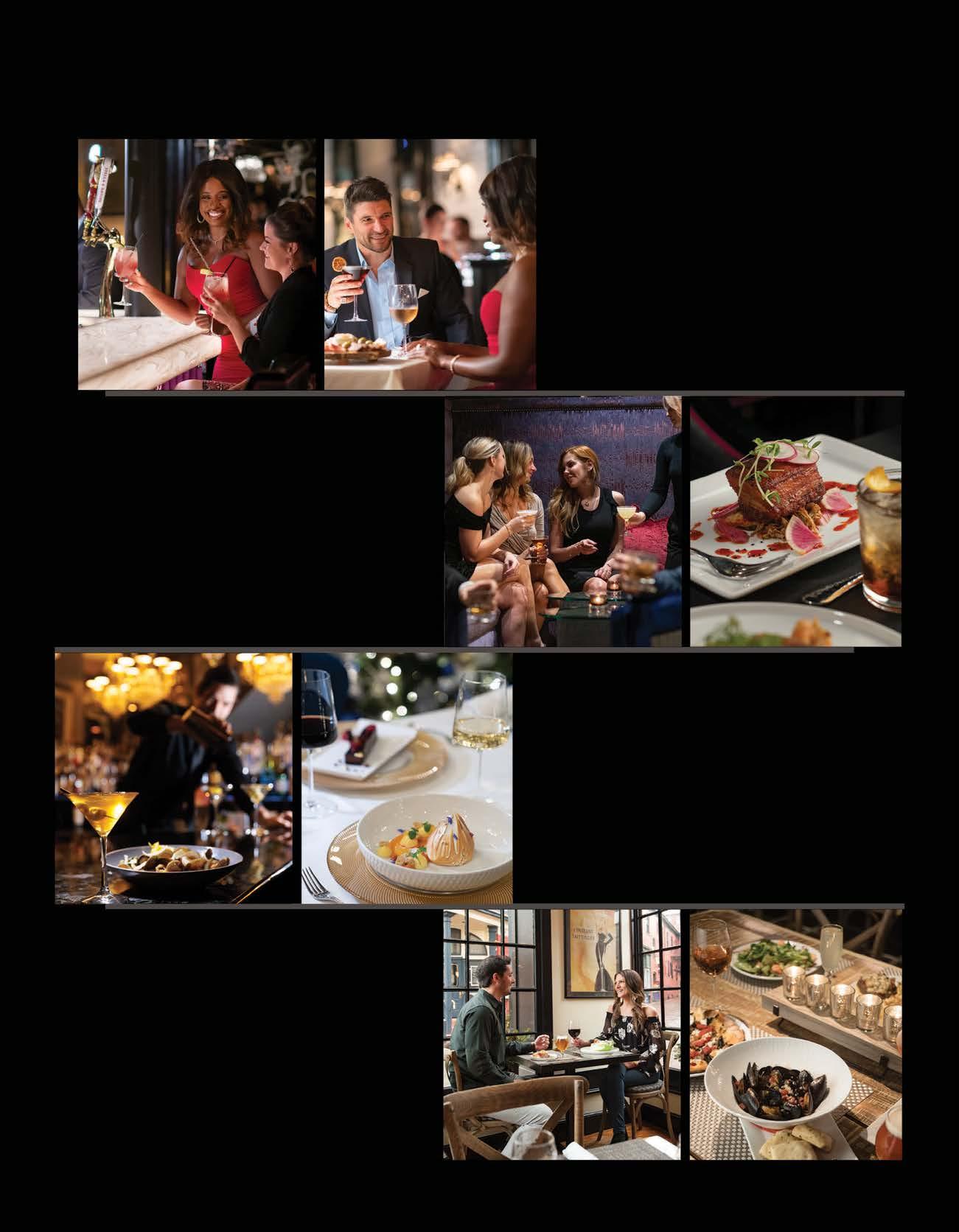
It appears that European gardeners – even the English –discovered the allure of Mediterranean-style gardens last season. Now the trend is crossing “the pond” and will be making an impact on American landscaping and gardening in 2023.
Readers who, like your columnist, have been gardening for decades, have seen many trends come and go. It took years for us to get over our enchantment with those deep English perennial borders that not only required a squad of gardeners to maintain, but sooner or later succumbed to our hot and humid summers.
The next trend we fell for was ornamental grasses – touted as lowmaintenance and the more the better. Right. Over the course of a few years, we learned they die out in the center and require the assistance of a rugby player to divide. But far worse, those Asian grasses have now seeded all through the
meadows and woodlands of our county. Just look, you’ll see them. As a result, I’ve removed all my Miscanthus plantings.
In recent years, the “New American Garden” has been the rage, highlighting native plants. It’s become a mania with some home gardeners. I try to appreciate their position, but we can’t overlook the countless non-native plants that deserve to be stalwarts in our borders. Besides, there are native plants that qualify as thugs. I also ask the question, native to where? Just the county? The eastern U.S.? One should not dispute that conifers (evergreens) from Asia are fundamental to providing structure in our gardens. And don’t forget that the much-loved and coddled turf grass dominating the suburbs is not native.
What can we learn from the gardens of Spain, France, Greece, Morocco and Italy? And why copy? While it may be trendy, the fact of the matter is the gardening style employed in those countries is determined by their hot,
BY DR. RICHARD L. BITNERdry, sunny climate. Notwithstanding the fact that some areas in the western U.S. had record-breaking rain and snow in recent months, global climate change is predicted to bring hotter and dryer conditions to our northeast summers.
The changes in our climate have been noticeable. Providing supplemental watering July into August has become typical. Families returning from a few days away, find their water-needy plants parched. Due to those circumstances, why not try to adapt our borders to this changing state of affairs?
Gardens in the Mediterranean are all about sensory experiences: vibrant colors, gravel paths, decorative tiles, stone textures, cane furniture, painted walls, terracotta pots and fragrant plants. Casual gatherings with friends. Coffee with a book enjoyed under a pergola. Low maintenance. Really.
Why not adapt this casual, elegant style to your own backyard? Such gardens have a timeless feel. Think of


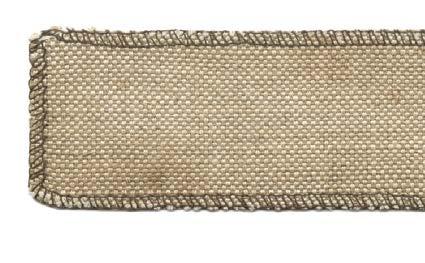



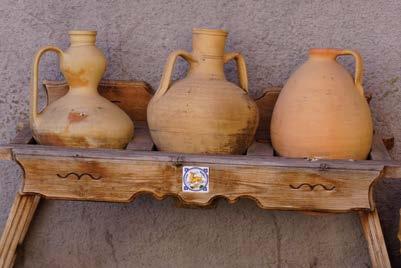
She Wanted to Help End a War, Not Start One!
April 6 – July 27

a Greek balcony or an Italian terrace garden. Some plants found in such gardens are native, but those grown in similar climates – California, South Africa and Mexico – obviously would be good choices for adapting the style to South Central Pennsylvania.
often the distinctive background colors that are seen in hot-weather countries. Perhaps paint just a section of a wall or an alcove because most of the color should come from the flowering plants.

A Son’s Journey. A Father’s Hope.
August 4 – October 19
It’s the Most, Wonderful Meal of the Year!

October 26 – December 30
Not valid on group tickets, previous purchases or with other offers. Valid on any of our 2023 shows. Book Early! Must book by 5/15/23.
All too often we think gardening is first and foremost all about the plants. But successful gardens start with structure. Mediterranean gardens incorporate natural materials in their walls and paving. The natural landscape of the area is mineral-based and entails lots of stone, sand and gravel.
Gravel is used for patios, paths and to mulch the plant beds. (Happily, the bark mulches your writer disdains have no place here.) The gravel paving takes the place of time-consuming, waterdependent grass. The light color of the gravel will reflect heat back onto the vibrant, sun-loving plants. Edges between gravel mulch and paving can be softened with low-growing fragrant herbs. Here and there some larger rocks or boulders can be arranged on the gravel (as long as it looks natural).
Characteristically, glazed tiles in patterns or pulsating colors are used on stair steps or as accents on walls or counters. These brighter touches are tempered by the earth tones of pavers on patios and terraces.

Sure, pastel walls look great as a background to plants, but why not jazz things up a bit by painting the walls in vibrant shades of terracotta, mustard, lapis blue or even magenta, which are so
A nice feature is a small pool or fountain (made from natural materials) to provide soothing relief from the reflected heat. For sure, include a bird bath not far away.
As the finishing touch for the style, patio furniture should preferably be a natural material like cane or rustic wood. And, of course, a pergola defining the dining spot with some climbing plants to provide dappled shade.
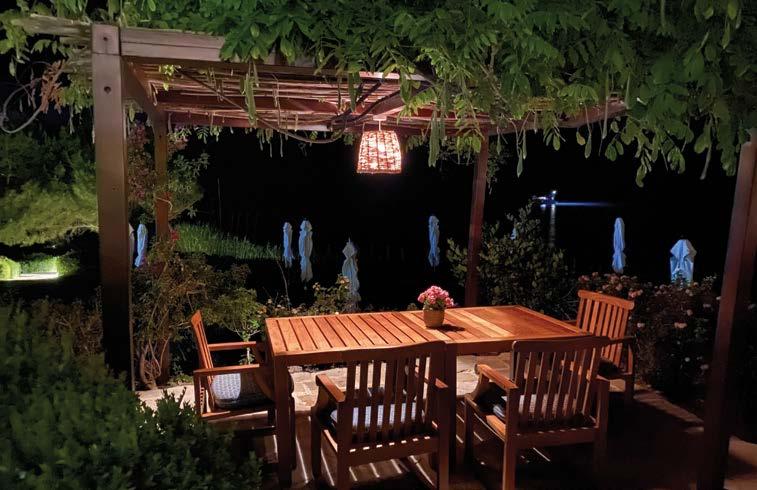
For a small urban garden or a suburban home that has added one of the “outdoor-living” terraces featured in “landscaping” (actually hardscaping) ads throughout LCM, perhaps the Mediterranean style is just the ambiance needed for relaxed, outdoor living even in temperate Lancaster County.
A south-facing site that receives six to eight hours of sun throughout the season but is also protected from the elements is ideal. If you already have light sandy soil, you’re ready to go, but if you garden on clay, you’ll need to mix in plenty of gravel to provide adequate drainage. Your plants will all require good year-round drainage. If the area you want to plant is frequently waterlogged, that is, it stays wet after heavy rain or snowmelt, you’ll either need to construct raised beds or put all your plants in pots. (Ensure good drainage in your pots by mixing in gravel, sand or perlite.)

Plants growing in conditions seen in Mediterranean countries prefer nutrientpoor soil, so hands off your beloved fertilizers! In next month’s Gardening Journey, I will suggest appropriate container and in-ground plant choices.




The warm color of terracotta pots is traditional in Mediterranean gardens to set off the vibrant colors of the

flowers, tiles and walls. Terracotta soaks up and reflects the heat and is available in pot sizes large enough to accommodate “architectural” plants like palms and yuccas.
Be certain the terracotta you purchase is frost-proof; it’s more expensive but will ensure that your pots get through cold winter weather. The cheaper versions from the box stores will shatter eventually when exposed to below-freezing temperatures. Also think about adding an enameled cobalt-blue container to contrast with the terracotta.
As you prepare your containers for planting, you’ll soon become aware of how heavy they become. Perhaps put them on casters before filling with soil if the planting will need to be moved to a

protected area during the winter. Display the pots in a sunny area and water only when the soil feels dry. Use a gravel mulch on the containers for appearance and to keep the roots cool.

SPEND THE EARLY SPRING readying your sunbaked patio for a transformation into a Mediterraneanstyle getaway. In next month’s column, I’ll provide your planting list. By then, soil will have warmed up and our splendid local nurseries will be well-stocked. This summer you will be transported to another world just outside your door. Only missing is a view of the sea and a bocce-ball court!



Spring is a reawakening. The season adds life to a world that was cold and gray. It invites you to get organized, get outdoors and get moving. Spring welcomes you to feel the warm rays of sun on your face again and enjoy a picnic, spend a day at the park or out in the yard with the kids.

Itis the season for spring cleaning and starting a clean slate. It’s the perfect time to shake things up and redecorate a tired-looking room or an outdoor patio. Whether it’s shopping for an updated look, new kitchen lighting or new outdoor furniture, Lancaster County is blooming with retailers, landscape artists and other friendly businesses waiting to help you “spring” forward this season.
The COLUMBIA MARKET HOUSE is a treasure located in the heart of this historic river town. The plans for this structure originated in 1868 with Robert Crane. Opened on September 17, 1869, the market has served as an anchor for this community. While visiting, take a tour of the well-preserved dungeons from 1834, including a solitary confinement cell. In 2019, after being closed for a few years, Columbia, in partnership with the state, once again invested in this building and on May 29, 2021, the Market House reopened with a restaurant, stand spaces and room for special events.

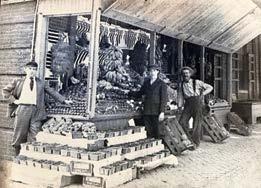
15 South 3rd Street
Columbia, Pennsylvania 17512

Open Saturdays, 7am-3pm



COLUMBIAPAMARKETHOUSE.ORG
JURA is the leader in automatic coffee machines, offering a bean-to-cup experience that is freshly ground, not capsulated. JURA machines produce the finest high-pressure-brewed coffee, espresso, cappuccino and more. Thanks to the introduction of Cold Brew Extraction Process, the new JURA Z10 is the first to prepare both hot and cold brew specialty coffees. Additional innovations include Pulse Extraction Process (P.E.P.®), which optimizes extraction time to


Founded in 1983, Lancaster Bicycle Shop has been meeting the cycling needs of the Lancaster area for 40 years.

1138 MANHEIM PIKE | 717-299-9445
LANCASTERBICYCLESHOP.COM
develop the full flavor of espresso, macchiato and cortado –plus the Intelligent Water System (I.W.S.®) and integrated cleaning and maintenance systems. JURA’s app, J.O.E.® (JURA Operating Experience), allows users to operate selected machines from their phones or tablets.
Founded in 1983, LANCASTER BICYCLE SHOP has been meeting the cycling needs of the Lancaster area for 40 years. Lancaster Bicycle Shop, located on Manheim Pike, provides quality bicycles for the entire family at competitive prices, including bicycles for road, off-road and casual rides, as well as kids bikes, e-bikes and used bikes. Also, find gear such as bike racks, helmets, shoes and more. Lancaster Bicycle Shop also offers free estimates and prompt repairs so you can get back to riding as soon as possible. From new bicycle sales to comprehensive service, their team is ready to help you ride.
ACHENBACH’S PASTRIES, INC. has been doing business since 1954 “with our made-from-scratch original recipes,” shares the company’s executive vice president, Sharon Redcay. “What sets us apart from most bakeries is the ‘no preservatives’ in our products.”
yourwedding!upcoming
yourwedding!upcoming
“Made from scratch” recipes since 1954

10% off any tier cake order that is paid at least 2 weeks prior to the delivery/pickup date


Traditional round, square, hexagon, and heart-shaped cakes
Call us to set up a free consultation with one of our decorators
375 East Main Street Leola, PA 717-656-6671
www.achenbachs.com

Achenbach’s most popular item would be their Long Johns. “After all, we are trademarked ‘The Home of the Long John.’ We also make Long John all-occasion cakes and Long John wedding cakes by special order only,” Sharon adds. “Trending wedding cakes are the naked cake and the textured icing with a spiral look.”

A beautiful backyard shed from FOX COUNTRY SHEDS is the perfect solution for your storage needs. For example, the Rancher Shed’s extra-tall height and overhead loft provide the perfect solution for out-of-the-way storage. Or convert your new shed into a home office or gym! Customize and view your storage shed ideas in 3D when you visit their website. You can even “place” your new shed right in your backyard virtually with the Augmented Reality feature. Whatever your storage needs are, adding a “Fox Shed” will add valuable storage space to your home while enhancing the exterior of your property.
HARVEST SEASONAL GRILL believes that everyone should enjoy nutrient-dense, farm-fresh flavors. Every three months, they introduce an all-new, seasonally inspired menu created with honest ingredients from local farm partners.
Harvest also offers private dining space and off-site catering services. Perfect for birthday celebrations, holiday gatherings, corporate board meetings and


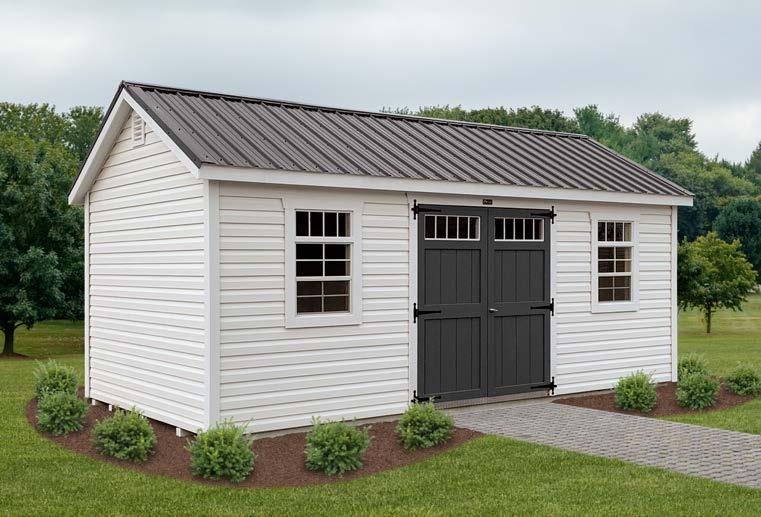

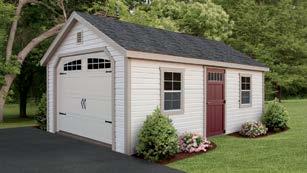




The Area’s Largest Selection of


wedding receptions, Harvest’s attentive service and farm-to-table menu will make your event spectacular, whatever the occasion.
Whether you are dining at one of their convenient locations or searching for the perfect caterer for your private event, Harvest Seasonal Grill looks forward to introducing every guest to “farm-to-table for everyone.”
BOWMAN’S STOVE & PATIO , located in Ephrata, has noticed a major increase in demand for outdoor furniture since people are spending a lot more time at home. Popular this year are gas fire-pit chat tables paired with curved cushion sofas and cushion swivel rockers. Large dining tables are also popular, such as rectangular extension tables that seat eight to 10 people or octagon- and hexagon-shaped tables that seat six or eight. Bowman’s Stove & Patio recommends shopping as early as possible, so that you have furniture in time for the spring/ summer season.

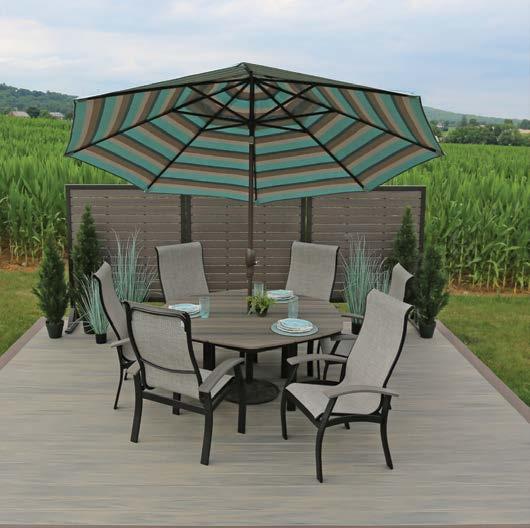
With a breathtaking view of the Susquehanna River, locally sourced food and dedicated staff, JOHN WRIGHT RESTAURANT is an all-in-one location for your special occasion. As a full-service venue, they can accommodate bridal and baby showers, rehearsal dinners, corporate parties, weddings and any other reason to celebrate. Large events can be held in the River Room, while the venue can accommodate smaller celebrations in their main dining room, outdoor dining room or on their seasonal pizza patio. John Wright Restaurant is proud to offer a wide variety of options to make your special event memorable and hassle-free.
In 1954, the late George Grove Sr. started what later became GEORGE J. GROVE & SON, INC. The familyowned business, now in its third generation, is built on a firm belief in quality products and installation and in maintaining professionalism, integrity and fairness in their relationships with their customers. George J. Grove & Son, Inc. provides all types of home improvements. Their product lines include windows and doors, roofing, vinyl siding, spouting, gutter protection systems and patio enclosures. They also carry skylights, shutters, railings and retractable fabric and metal awnings.






Family-owned and family-focused for almost 30 years, ASPEN HOME IMPROVEMENTS offers trusted roofing, window, door and siding replacement services. The Aspen team takes a personalized approach to each home they work on, treating every home like their own. Every product Aspen uses is proudly made in the USA and their trusted team has been rated five stars on Google and Angi’s List. Contact Aspen Home Improvements today to schedule a free (noobligation) in-home consultation with a sales representative. Learn more about Aspen on their website or by scanning the QR code for a special message from the Aspen team!


NOAH F. BOYLE CABINETS, located in Elizabethtown, has been designing, building and installing custom cabinets since 1993. Noah F. Boyle Cabinets creates high quality kitchen and bathroom cabinets with craftsmanship to the last detail. From design to installation and beyond, Noah F. Boyle provides excellent customer service and attention to detail through every step of the project. “The cabinets are a work of art,” says one satisfied customer. Call 717-944-1007 to find out how Noah F. Boyle Cabinets can help you create your dream kitchen or bathroom.


KREIDER’S CANVAS SERVICE, INC. has been installing awnings in Lancaster County for over 40 years. Leslie Kreider shares that Kreider’s Canvas offers an option that makes outdoor areas more useful and comfortable. “We developed a ‘Roof Vent System’ that can be used on the flat back wall of a deck or patio canopy. This increased venting area provides more air flow and minimizes trapped hot air,” Leslie says. What’s trending? “There has been an increased use of side curtains around porches and pavilions to block wind when needed, while still having the ability to open up to full view of the outside.”
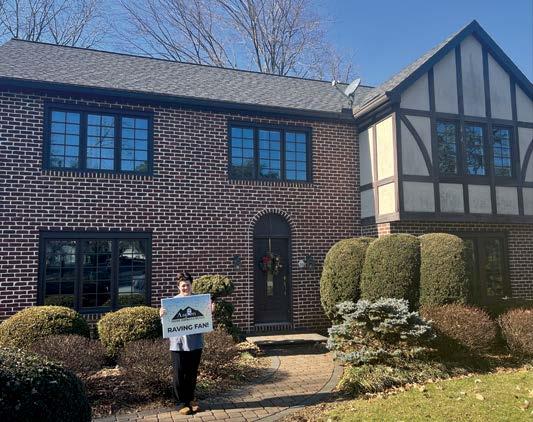
KEYSTONE GUN-KRETE, LLC specializes in lifting sunken concrete slabs of all sizes. Owner Richie Zook says, “If you’re looking at a sunken pool deck, patio or a section of sidewalk at your home or business, the cost savings to have it lifted instead of replaced can be huge. Plus, it’s done in hours instead of days and without the mess.” Keystone Gun-Krete simply drills small holes through the slab and injects their expanding foam below to raise the concrete back to its original location. The holes are then filled with mortar so the concrete is ready for foot traffic immediately.


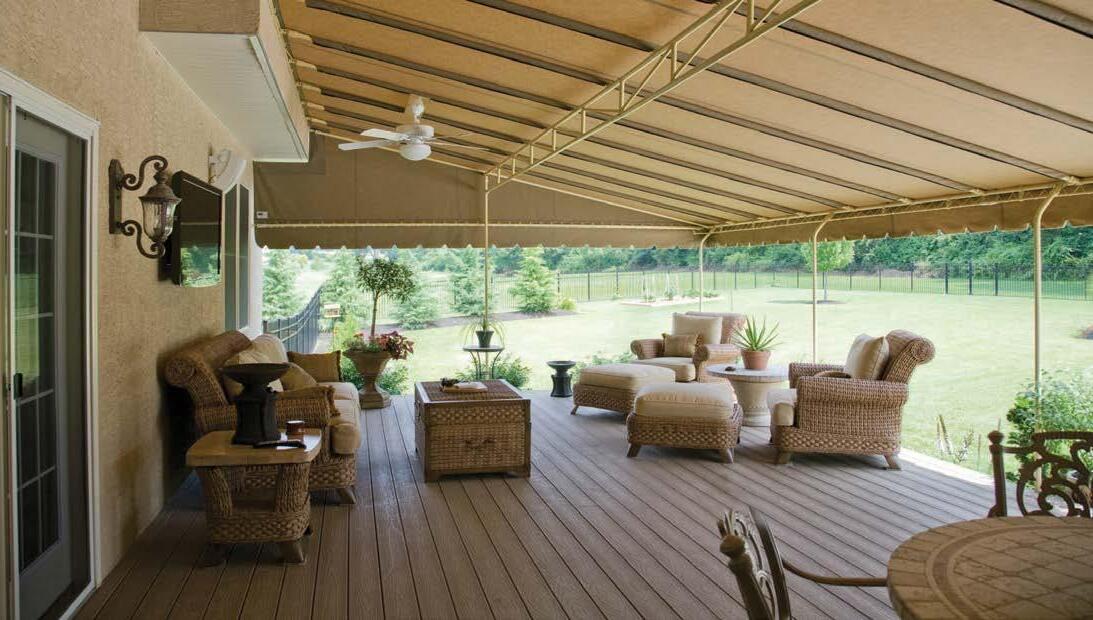

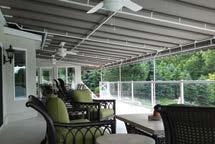
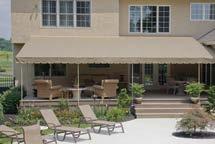

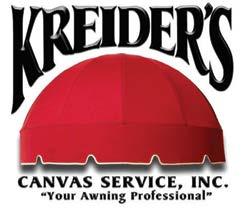



PRECISE BUILDINGS is based in Lancaster County, central to an area rich in heritage and timeless estates. While Precise is known for providing distinctive equestrian structures, they can also create and custom build an outdoor structure to your specific needs. With over 25 years of success in design and construction, their highly skilled craftsmen pay attention to all the details to make your finished project unique to you and your property. If you are considering building or renovating, view their work by visiting their website or call their design team today at 717-768-3200. Precise Buildings will build your dreams and preserve your legacy.
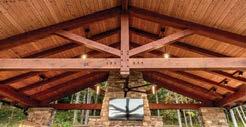

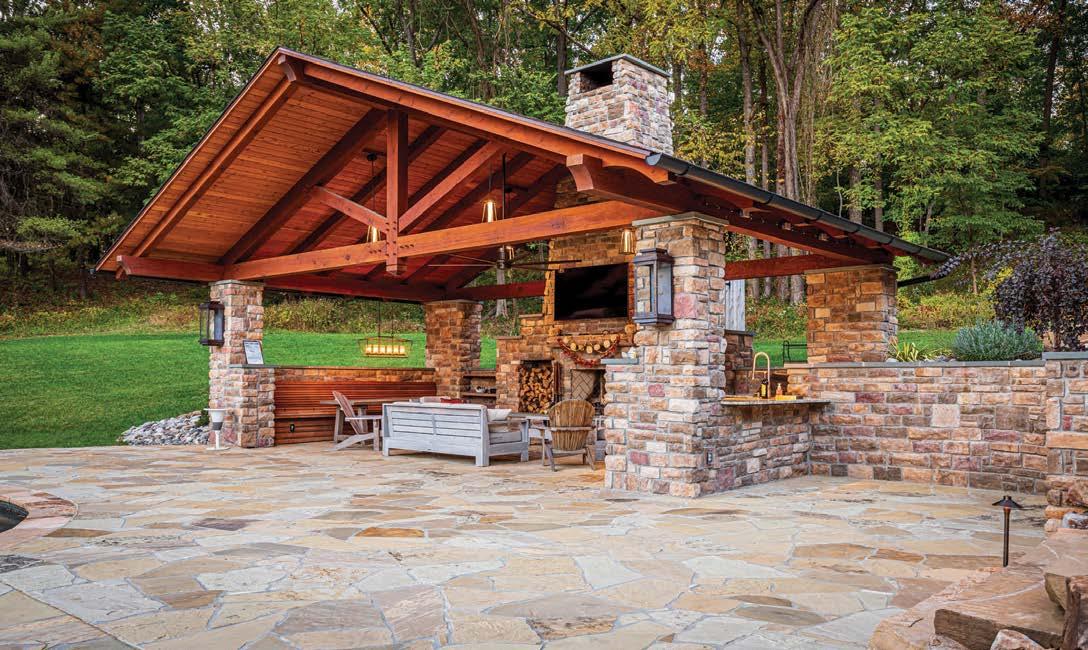

LUSK AND ASSOCIATES SOTHEBY’S INTERNATIONAL REALTY is South Central Pennsylvania’s premier real estate agency, combining the experience and knowledge of their agents with the excellence of Sotheby’s International Realty. Located in Lancaster County, their sole responsibility to their clients is to make sure all their needs are met, from the first meeting to the settlement table, and after the transaction is completed. Lusk and Associates are centrally located to assist in finding that unique or exquisite property that everyone dreams about.


Photographer Jordan Bush’s assignment was to capture Lancaster County from above. Using his quadcopter drone, he visited a variety of sites across the county from late August to early December of 2022. As we reviewed the shots, it occurred to us that they provide evidence that Lancaster is “green” in more ways than the obvious one.
 PHOTOGRAPHY BY JORDAN BUSH | WRITTEN BY SUE LONG
PHOTOGRAPHY BY JORDAN BUSH | WRITTEN BY SUE LONG
Restoration. Adaptive reuse. Ecotourism. Agritainment. Green spaces. Nature preserves. Rail trails. Heritage areas. Sustainability. Such words are becoming associated with Lancaster County. Increasingly, visitors are coming here to experience our natural areas, diverse restaurant scene, cultural offerings and history. Yes, they are still interested in all-things Pennsylvania Dutch, but their interests have broadened, and they want to experience all that Lancaster has to offer. Even our barn venues and historic properties are attracting wedding parties from outside the immediate area.
The pandemic helped to convince locals that Lancaster County has a good thing going for it from an outdoors perspective. Seeking a reprieve from lockdowns, they flocked to parks, rail trails and nature preserves in record numbers. The phenomenon continues: visit small towns along the river trails and it’s obvious locals and visitors alike are enjoying the great outdoors, as well as exploring local shops and restaurants.
OF COURSE, social media and coverage in national publications (the March issue of Better Homes and Gardens featured foodie destinations in Downtown Lancaster) are helping to highlight Lancaster’s varied attractions. Visitors still seem to be enraptured by cows and horse-drawn buggies, while locals are sharing river scenes, wildlife visiting their backyards and menu items from their favorite restaurants. In February, ice sculptures in Lititz dominated social media postings. Now that spring has arrived, we’ll no doubt be seeing photos depicting our gardening efforts.
YES, LANCASTER COUNTY is a place we can all be proud to call home. Hopefully, the photos taken by Jordan will further remind you that we live in a very special place.




According to Penn State Extension, farms of all sizes have been turning to agritainment –pick-your-own fruits/vegetables/flowers, farm markets, festivals, corn mazes, farmstay vacations and more – to increase their incomes. Cherry Crest Adventure Farm in Ronks, has become a leader in this growing aspect of tourism.
Cherry Crest is a magnet for visitors to Lancaster County, as it boasts a fascinating history, scenic farmland, a neighbor in the Strasburg Rail Road and a corn maze that has appeared on USA Today’s annual “10 Best” readers’ poll for eight consecutive years beginning in 2014 (including first place in 2020 and third place the last two years).
From a historical perspective, the farmland once belonged to succeeding generations of the Ferree family, French Huguenots who immigrated to America in search of religious freedom and settled in the Paradise area in 1712. Over the ensuing years, the family prospered and came to own more than 2,000 acres of land. Cherry Crest, for example, was once owned by Cornelius Ferree (1753-1792). The renowned wagon maker welcomed settlers heading west to stop at the farm before they ventured into the wilderness.
Much of the original Ferree farmland is now owned by Plain and English farmers. Cherry Crest’s current owners, Jack and Donna Coleman, arrived in Lancaster County from New Jersey in 1987, to continue farming. After purchasing Cherry Crest Farm they raised dairy cows but later transitioned to beef cows and poultry (broilers raised for Tyson). In addition, they raise soybeans and corn on the acreage. Jack and their son, Dylan, have also developed a dust-control product called Dustkill that is marketed throughout the Mid-Atlantic region. Made with soybean oil, it is 100% plant-based, is non-corrosive and is renewable and sustainable. The eco-minded Colemans operate the farm with solar power.
LOOKING FOR OTHER ventures to augment the farm’s income, Jack noted the success of a corn maze at Lebanon Valley College and contacted its designer, Don Frantz of the American Maze Company. Their first joint venture (1996) employed a locomotive as its theme. Incredibly, nearly 30,000 visitors showed up to negotiate the maze.
Over the past 27 years, the enterprise has grown to offer visitors attractions such as a petting zoo, farm tours, farmthemed activities, an educational center, themed festivals, concessions, a gift shop and more. The Coleman family, which now includes a third generation, takes pleasure in providing guests with “wholesome family fun” and educating them about agriculture. They also like to think that they’ve brought the property full circle and are continuing Cornelius Ferree’s tradition of welcoming travelers to the farm. They paid homage to Ferree’s hospitality and wainwright abilities by making the Conestoga Wagon the theme of a past maze. For more information, visit cherrycrestfarm.com.


On autumn Friday nights across Lancaster County, grassy athletic fields bring communities together in support of their high school football teams. Nowhere is that sense of community spirit more evident than in Manheim.

The renowned Manheim Central Barons play their home games at Elden N. Rettew Field, which is part of a recreational and sports complex that spans more than 50 acres in the heart of Manheim. According to the annals of the Manheim Historical Society, Rettew, who was born in 1906 and died in 1985, viewed the development of the Veterans Memorial Park complex – baseball, softball and Little League fields; volleyball, basketball and tennis courts; swimming pools; playgrounds; farm show buildings; natural areas; a relocated and preserved covered bridge and, of course, a football field – as a labor of love. Rettew’s dedication to the project began after World War II, when he became involved with the Manheim Athletic Association, which purchased the initial 15 acres and bequeathed them to the borough as a “citizens’ gift.” (The area where the football stadium is located was once a cornfield.)
Rettew went on to serve as the chairman of the Manheim Field Commission, which oversaw the growth of the park, until 1980, at which time another entity assumed that role. As part of his responsibilities, Rettew made it a priority to beautify the complex with trees, shrubbery and other plantings.
To Rettew’s surprise and delight, the football field was named in his honor during a half-time ceremony that was held on November 12, 1982. The date was significant: It happened to be the avid Barons fan’s 77th birthday.
For information about the newest proposed addition to the park, a plaza dedicated to all who have served, visit manheimveteransmemorial.org.
Photographed October 14, 2022
To truly appreciate the city of Lancaster, you’ll need to take a walk. No doubt, you’ll become absorbed by the architecture and history that make it so special.

Last summer, I was fortunate to participate in a C. Emlen Urban walking tour that was led by Gregg Scott, an architect who is an authority on all-things Urban. The noted architect (Urban) designed such buildings as Watt & Shand, Hager’s, the Griest Building and Southern Market, as well as schools, churches, private homes, hotels, corporate facilities and monumental gateways to parks and cemeteries. In 1899, Urban supervised the construction of the grand Woolworth Building (designed by the New York firm of Schickel & Ditmars), which stood on the first block of North Queen Street until 1950. He maintained his office in the building for 37 years and designed all of its additions and renovations. According to Gregg, you name the architectural style and Urban could execute it.
THE GROUP MET at the corner of College Avenue and West Chestnut Street and slowly made its way to North Queen Street. It made for a fascinating morning. Traveling along West Chestnut Street on foot provides an altogether different experience, as you are given the opportunity to study the details that make the homes – several designed by Urban – so distinctive. Also of note is the Stevens School (now home to residences) that was designed by Urban.
NOW THAT I “know” Urban better, I wonder what Penn Square would look like without the façade of the Watt & Shand building that wraps around the Marriott Hotel. The first phase of the landmark store was designed by Urban and completed in 1898. Over the years, it grew to encompass seven other buildings on East King and South Queen streets.
The Hager Building, which dates to 1911, was another of Urban’s projects
and represents his initial venture into modern design. Fortunately, it, too, was saved/adapted, as its upper floors hold residences, while the ground floor has become commercial space. Lancaster’s first skyscraper, the Griest Building, was designed by Urban in 1925. Southern Market, which was designed by Urban in 1888, nearly met its demise on several occasions. Today, it’s a beautiful food hall whose vendors offer visitors a taste of the world.
AS FOR SOME interesting
Lancaster history, did you know that Andrew Ellicott tutored Meriwether Lewis on surveying techniques at the Sehner-Ellicott-von Hess House on North Prince Street prior to the Lewis & Clark Expedition? It represents one of the city’s many historic buildings
and warehouses that have been saved and readapted to serve other purposes. Appropriately enough, it now serves as the home of the Historic Preservation Trust of Lancaster County, which annually honors preservation, restoration and adaptive-reuse projects with C. Emlen Urban awards.

By the way, if you feel like taking an “Urban” walk, the Trust has compiled a C. Emlen Urban Architectural Tour Book that can be purchased online at hptrust.org
Photographed October 28, 2022

Barns are beloved landmarks in this area of the state. One in particular has always intrigued us and caused concern about its longevity.
Now fully restored after being moved from Dauphin County to Stone Gables Estate in Elizabethtown, The Star Barn has a new lease on life.
Likemost Central Pennsylvanians, David Abel had driven by The Star Barn throughout his life. He was aware of the various efforts that had been made to save it. He never envisioned himself playing such a role until his wife, Tierney, suggested they save the barn and restore it to its original glory. They were rewarded with a C. Emlen Urban Award for their efforts.
Built by Colonel John Motter in 1877, The Star Barn was used to house his prized horses. Motter, who was a man of faith, conveyed his belief in God and country through the barn’s design that was distinguished by towering cupolas and louvered ventilators. Built a dozen years after the Civil War ended, the five-pointed stars seen on the barn represented Motter’s hope that the reunified country would prosper once again. The stars also represented the five distinctive wounds Christ suffered at his crucifixion. Other faith-oriented elements included cathedral-style windows, barn spires that pointed toward heaven and fleur-de-lis finials that represented the Holy Trinity.
In the late 1920s, the farm became a dairy operation; over the course of time, the 164-acre spread was reduced to just under four acres. By the latter part of the 20th century, encroaching development, neglect and the environmental stresses related to traffic on nearby Route 283 caused the barn and its complementary outbuildings to further deteriorate. Despite its condition, The Star Barn was added to the National Register of Historic Places in 2000.
IN 2014, the Abels and DAS Companies acquired The Star Barn and the other outbuildings. Over the course of several months, the buildings were meticulously disassembled. With West Donegal Township providing zoning approval, plans to move the structures to Elizabethtown proceeded. Excavation began in spring 2016 to create a site for them to be rebuilt. Working with a host of companies and individuals who possessed the craftsmanship and vision to restore and preserve such a treasure, the Abels were able to utilize 90% of the structure to rebuild the barn. However, its exterior is actually new construction. The purpose of taking that route was to protect the original barn and to conceal modern-day materials such as steel beams, wiring, insulation, climate-control systems, etc.
Completed in 2018, The Star Barn Village has become an events venue that hosts weddings and other social occasions, as well as seasonal events that are open to the public. In addition, net profits from such events benefit Brittany’s Hope, a nonprofit organization founded by the Abel family in 2000, which aids orphaned, at-risk and special-needs children worldwide.
For more information, visit stonegablesestate.com.

Lancaster County is becoming a prime destination for those who love the great outdoors. Thanks to rail trails, nature preserves, waterways and the Susquehanna National Heritage Area, ecotourism is impacting the region.

The latest addition to Lancaster County’s growing reputation as a top-notch outdoor destination can be found along the Enola Low Grade Trail, which follows the Susquehanna River from Turkey Hill south to the Safe Harbor area and then travels eastward to Atglen. After more than eight years of planning and construction, the rehabilitated Safe Harbor Trestle Bridge that once carried rail traffic over the intersection of the Conestoga and Susquehanna rivers and connected Manor and Conestoga townships, is now conveying hikers, dog walkers and bicyclists, as they travel along the continuous 30-mile stretch of trail.
Originally constructed in 1905, the steel bridge, which was built to carry rail traffic for the Atglen and Susquehanna Branch of the Pennsylvania Railroad, was considered a marvel of engineering. Measuring 140-feet high and 1,560-feet long, it was the second-longest bridge of its kind in the state and the third highest in the country. Listed on the National Register of Historic Places, it last saw service in 1989.
When the upper 5-mile section of the Enola Low Grade Trail opened in 2013, restoring and readapting the bridge became a priority. Thanks to municipal, state and federal funding, as well as private donations, the goal became reality last June, when the $9 million project, which features concrete and glass decking, officially opened to trail traffic. Users marvel at the views the bridge offers, including the rivers, woodland, the Safe Harbor Dam, York County, railroad traffic and the famous petroglyph-covered rocks that dot the Susquehanna.
TRAIL USERS WERE also excited by the announcement that work had been completed on the restoration of the Martic Forge Trestle Bridge, which was also built in 1905 and spans the Pequea Creek. The restored bridge, which is nearly as high as Safe Harbor’s and is 634-feet long, was compromised in 2018, when an arsonist set it ablaze. Funding issues and Covid created setbacks, but the $3 million funding issue was resolved through the acquisition of state grants, enabling work to progress on creating a concrete and galvanized-metal deck for the bridge. It reopened in late October 2022.
For details, visit enolalowgradetrail.com and unchartedlancaster.com.
Photographed October 22, 2022


Often called “wild leeks,” ramps are delicate, coolweather vegetables similar to chives or onions. This ephemeral plant is easily over-foraged, which has led to ramp patches – including a few in this area – becoming closely guarded secrets.

the past, only one “outsider” was granted the opportunity to visit a well-guarded ramp patch that is harvested by Jim Switzenberg, the owner and executive chef at the John Wright Restaurant. To my delight, I became the second. While I was granted permission to bring a camera to the location, like the person who visited before me, I was required to wear a blindfold and turn off my cell phone so that I could not identify the
route we took to get there or pinpoint its exact location. I must admit, the CIAlike maneuvers were well worth it. Upon arriving, I was introduced to the mother lode of ramp patches!
If you grew up going to mountainous destinations such as Wellsboro and Coudersport in Tioga and Potter counties respectively, you may have noticed local fire companies advertising ham-and-leek dinners. Growing in cool weather, ramps (Allium tricoccum) are bulbed vegetables with flavor characteristics adjacent to onions, chives, scallions or larger, cultivated broadleaf leeks. In such places, ramp-digging is a pastime, while the aforementioned dinners are held to celebrate the arrival of spring and benefit local fire companies and other organizations throughout the Appalachians. West Virginia appears to be the epicenter of dinners and festivals
that are dedicated to ramps. Searching for ramp sources closer to home (Lancaster and York counties are about as far to the east as they grow), I came across an Etsy “store” that listed ramp oil for sale by WrightsvilleFoods. Knowing the John Wright Restaurant offered ramps for sale and infused menu items with them in the spring, I thought there must surely be a connection. It also occurred to me that for a restaurant to procure the number of ramps that would be needed for such purposes, they would need access to the mother lode of ramp patches.
As it turns out, WrightsvilleFoods is a part of John Wright Restaurant’s efforts to diversify revenue streams for greater stability. John Wright Restaurant is also home to The Real Food Emporium, which is stocked with an ever-changing selection of unique take-out items and cooking ingredients. The new operations were launched to fulfill a need during the pandemic. “We
never want to be in a position where we can’t take care of our employees,” Jim explains.

THE OPPORTUNITY to add ramps to the menu arose roughly seven years ago when guests questioned Jim about his familiarity with ramps and if he knew what to do with them. One of the guests explained, “I hear I have a gold mine of ramps.” As it turned out, the guests’ property is home to a ramp patch they had been mowing over for 25 years. “Every year when we run a ramps special, we’ll invite them down,” says Jim. “I give them purée, as much as they want. I taught them a few dishes to impress their friends. These guys know that I really care. For us, it’s communityto-table.”


Visiting this acclaimed ramp patch took more than a year of conversations and planning before Jim would eventually agree to take me along on a foraging trip. It was decided that I would have to go in blindfolded. Spared from knowing the location of their ramp patch, this protected the source and I’d be freed of inquiries on how to get there (so don’t ask!). In the spring of 2021, I narrowly missed the first opportunity after uncommonly warm weather literally steamed the ramps in the ground. The damp soil and jarring heat turned the ramps yellow overnight, abruptly ending the foraging season at a third of its usual duration of six to eight weeks. Larger harvests come at the end of the season, leaving yields low and so, my foraging trip had to wait another year.
In April of 2022, the day finally arrived. It was a picturesque spring morning at the restaurant that awards guests with stunning views of the Susquehanna River. Nature roused from its annual slumber beneath clear skies, as the warm sun fended off the cool, brisk air. We met outside the restaurant, where I was greeted by Jim and his dog, Zeke (Ezekiel), who was every bit as excited about our expedition. “What every forager needs is a good dog who wants to go with them,” says Jim. “He knows. He knew the season was coming,” he says of
something special was in
Zeke sensing Clockwise from opposite page: Harvested ramps showcasing white bulbs and green leaves. Wild ramps propagate through the division of bulbs and through seeds produced in the fall. John Wright Restaurant’s owner and executive chef, Jim Switzenberg, with his dog, Zeke, ahead of their first foraging trip of 2022. Jim reports that Zeke knowingly anticipates harvest time, as it allows him to explore the myriad of scents and curiosities of the ramp patch. A massive, Wrightsville-area ramp patch conserved in part with the John Wright Restaurant, is located on private land. Locating a patch of ramps filling the area of a square yard is typically considered a success. Healthy wild ramps display broad leaves that grow to about 4-inches wide. Preferring cool, damp conditions, ramp leaves develop in early spring and wilt in the warmth of late spring.store that morning. As Jim gathered his foraging tools, Zeke and I settled into the front of his truck. “We’re going harvesting, not foraging,” says Jim with a lofty grin. Powering off my phone to disable GPS, I pulled my baseball hat over my eyes and our adventure began.
Arriving at our undisclosed location, we found ourselves surrounded by ramp patches. “Just wait,” Jim exclaims. “We’re not even there yet!” Even if someone had no idea what ramps look like, their presence is alerted by your nose. The air offered fresh scents of spring, laden with robust notes of sweet onions or perhaps garlic. It was a familiar smell, yet somehow new. We walked a short distance and Jim’s grandiose claims materialized. A dense swath of green leaves filled the wooded hillside. I started to question if a camera could capture the massive scale of this ramp “patch.”
Like Jim, I soon viewed this place as special. He understood the resource that grew before us, the importance of growing and protecting the patch by limiting harvest to sustainable, though still incredible, volumes. “We treat it like conservationists,” he says, explaining that by harvesting 100
pounds of ramps, John Wright’s chefs can produce 15 gallons of purée. Jim is the right person to utilize this patch. He respects it and the landowners, cherishes it, shares it and even utilizes it to foster the local community. I suspect that 25 years of mowing over the patch and not harvesting from it made it what it is today, since the lawnmower blades helped to disperse seeds and force new growth. Jim has essentially taken that development a step further by bringing the flavor of ramps to the community through the John Wright Restaurant in a sustainable, easily attainable way.
While ramps are a perennial plant returning each year, they are incredibly slow to propagate. This is the reason foraging must be sustainable or else ramp patches will disappear. Ramps multiply in one of two ways: splitting bulbs in the soil or germinating seeds dropped later in the year. According to Dr. Eric Burkhart, program director at Shaver’s Creek Environmental Center and associate teaching professor at Penn State College of Agricultural Sciences, it can take three to five years until the seed turns into a bulb, creating a conservation issue. In the wild, if each
forager harvests 10% of a patch, in no time at all it will become depleted. Because the land-use legacy throughout Pennsylvania has changed often over the past 300 years, ramps have been removed. As lowland areas were cleared for agriculture, they became scarce. “People are starting to chip in to move plants around,” says Dr. Burkhart. Once considered a lowerclass food due to the smell, “We’ve gone from rags to riches when it comes to ramps,” he notes.


Depending on the region and weather, ramps can be ready to forage anywhere from the end of March into early- or mid-April. Waiting as little as four weeks to harvest in May will require less than half as many plants to produce an identical volume of smaller, less mature ramps. This can make all the difference in terms of sustainability

and even flavor, as it’s more developed in mature plants.

WHEN HARVESTING, select only the most mature ramps (with three large leaves) on plants that have a seed stump from the previous year. Mature plants should be surrounded by smaller seedlings, which can be moved to start new patches if replanted quickly. In commercial operations, ramps are harvested from rotating or gridded areas.
Some advocates encourage only harvesting the leaves and leaving the bulbs in place. In any case, harvesting must be sparse, not done in groups or patches, while trying to leave the soil undisturbed to keep weeds down. Think to cull, not clear. Harvesting, not destroying.
IF YOU’D LIKE TO forage for ramps, start by looking for them on shaded, northeast-facing banks. Their stalks can be red or green, usually with three and sometimes four leaves. Ramps can tolerate full sun if there’s enough moisture nearby to stay hydrated. They prefer damp soil rich in calcium and low in acidity. Nearby trees that thrive on water sources can be clues to finding them; they include sugar maple, tulip poplar and slippery elm. Carry a soil or garden knife; I prefer the Japanese-style hori hori knife. Also carry a drain spade to tilt the soil and carefully pry ramps out of the ground. Remember to pat down the ramps you don’t intend to harvest.
Bulbs will last up to three months in cold storage, while leaves will start to wither and yellow in a matter of days (store them in a Mason jar with a little cool water to keep moisture in the stems).
Ramps, which are high in Vitamin C, can be fermented and pickled. Fresh ramps can be sautéed in butter with
mushrooms or pasta. They can also be stir-fried or used to create pesto and flavored butter. Dried bulbs can be ground into powder and used in place of garlic powder or salt. Ramp oil purée preserves and extends the availability of ramps throughout the year while adding pungent flavor in smaller amounts across many dishes, including stews, eggs, pizza and bread. The possibilities are endless!

ATTITUDES HAIR & NAIL SALON
Celebrating 25 years in our mission of helping you LOVE your hair and nails! We specialize in trendy and traditional hair design, refreshing color, brightening highlights and perms for added style. Rejuvenate your hands and feet with relaxing manicures and pedicures. Thank you for trusting us to help you look and feel your best and voting us “The Best” hair and nail salon in 2022.
798A New Holland Avenue, Lancaster. 717-295-0836.

GAY COX
A Solo Exhibit
APRIL 4 - 29
Red Raven Art Company 138 North Prince Street Lancaster, PA 17603 www.redravenartcompany.com 717-299-4400
Nathan Mountain, Broker/Owner/Agent

Nathan.mountain@eramountainrealty.com 717-572-7423(cell) • License # RM421222

Nathan Mountain, Broker/Owner and Real Estate Agent of Mountain Realty ERA Powered, offers SUPERIOR real estate services to his clients whether they are relocating to or moving within the Lancaster County area or outlying areas. The goal of ALL Mountain Realty ERA Powered agents is to be an ADVOCATE for you through the entire process of Buying, Selling and/or Investing.
2938 Columbia Avenue, Suite 602, Lancaster. 717-390-8701. www.eramountainrealty.com.

Our chefs have been serving Lancaster Countians their favorite entrées for 43 years. To add variety, they are always creating new and exciting specials. Vegetable entrées and children’s menu available. We offer lavish lunch and dinner menus, made with quality, fresh ingredients, for dine-in or take-out. 1807 Columbia Avenue, Wheatland Shopping Center, Lancaster. 717-394-4336.
Presented by WHERE & WHEN PENNSYLVANIA
CALVARY CHURCH CAMPUS, 1051 LANDIS VALLEY ROAD, LANCASTER FREE ADMISSION
pafamilytravel.com

Check our website for a complete list of exhibitors, drawings and activities




Amazing getaways and prize drawings throughout the day!


One lucky attendee will win an all-inclusive family vacation! Free fun for kids, including the WJTL Kids Cookie Break from 9AM-noon, Papa Tater Magical Comedy Entertainment show at noon, Clyde Peeling’s Reptiland Tropical Rainforest Show at 2PM, our Passport to PA activity and mascots.

Sustainable secondhand shopping at ReUzit on State starts with thoughtful donations. Begin your spring cleaning by decluttering a closet, the basement or garage and bringing your quality donations to ReUzit on State. When you donate and shop, you are impacting neighbors locally and in 50 countries around the world through Mennonite Central Committee.


1054 S. State Street, Ephrata Reuzitonstate.org
Galebach’s Floor Finishing, founded in 1924, is the oldest floor finishing company in Lancaster County. We specialize in residential wood floor refinishing and have extensive experience with historic restorations. Our dust containment system keeps your home as clean as possible while our workers are on-site sanding and finishing. (#PA019030)
1148 Old Line Road, Manheim 717-898-9680

Galebachsfloorfinishing.com



CASEY JONES’ RESTAURANT
All aboard! Join us in our two original P-70 80-ton dining cars that once rode the rails of the Pennsylvania Railroad. Featuring 175 seats, this unique property offers indoor dining, outdoor deck seating with train and farmland views, and take-out. Serving breakfast, lunch and dinner daily, Casey Jones’ Restaurant is a one-ofa-kind experience for all ages!
312 Paradise Lane, Ronks 717-687-5000
CaseyJonesRestaurantPA.com


Finding contentment with what one has can be difficult, especially for children. In an often materialistic society, many kids experience the pressure to fit in with peers through possessions such as trendy clothes or the latest gadgets. Local author, Jessica Whipple, addresses the “fuzzy boundary between wants and needs” in her debut children’s picture book, titled Enough Is… The book poses the question: How many friends, clothes, toys or books are enough?
 BY KAYLEE REX
BY KAYLEE REX
The 32-page book, illustrated by Nicole Wong of Fall River, Massachusetts, follows one child as she learns the difference between wants and needs and, in the end, feels the contentment that comes from being satisfied with what she has. Published by Tilbury House, Enough Is… is recommended for children ages 6-8 years old and will be available to the public April 18. Aaron’s Books in Lititz will be hosting a launch event for Jessica’s debut book on Sunday, April 16, at 2 p.m.
Jessica, along with her husband and two young daughters, recently moved from Pittsburgh to Lancaster. Jessica has another book on the way this year, titled I Think I Think a Lot, which will be available to the public August 29. Ahead of her debut book release, Jessica shared a glimpse into her journey to become an author.
Q: When did you realize you wanted to be a writer?
A: I have a communications degree, so writing has always been a component of any traditional “job” I’ve had, whether as a copywriter at a marketing agency or writing a newsletter for a nonprofit. But the inkling to see if I could write a picture book came when I was a young mom with a toddler and an infant. It started as curiosity: “Could I do this? What does it take to write and publish a book?” And the more I dug into those questions, the deeper my research took me [and] the more excited I became at the idea.
Q: Why children’s books?
A: I like the interplay between images and text that’s balanced so perfectly in picture books. They’re the smallest iteration of an idea, in a perfect package of art and words. I like squeezing something big into such a small space.
Q: What inspired you to write Enough Is…?
A: I don’t know where ideas come from, but I don’t feel 100% responsible for my own. Maybe they come from God? All I know is, I didn’t have the idea, and then I did. I know it was fueled by my desire to share things about the world with my own children.
Q: Can you tell me about your other upcoming book, I Think I Think a Lot?
A: That one’s inspired by my experience with OCD, or obsessivecompulsive disorder. It follows an overthinking, worry-filled child as she compares her own thinking patterns to those of her friends. They seem troublingly different, but she comes to discover the beauty in her own way of experiencing the world.

To learn more about Jessica, visit authorjessicawhipple.com.
When: Sunday, April 16, at 2 p.m.
Where: Aaron’s Books, 35 East Main Street, Lititz
What: Jessica Whipple will be celebrating the release of her book, Enough Is…, with a book signing. Enough Is… can be preordered from Aaron’s Books or purchased at the event. Only books purchased at Aaron’s Books can be signed at the event. RSVPs are required via aaronsbooks.com.

A diagnosis of cancer is overwhelming. Locating an experienced cancer care team led by expert physicians without the added stress, time, and expense of unnecessary travel doesn’t have to add to the challenge.

We offer patients the most advanced chemotherapy treatments, compassionate care, and support at our office which is conveniently located on Lampeter Road.
New patients and second opinions will be seen within 24 hours, call 717.291.1313.
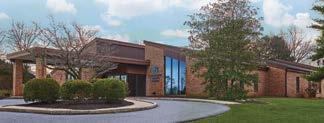

What was your Situation?
Looking ahead, it was time to enjoy life! After retiring, I decided to get myself in shape–eat better, exercise regularly, visit the grandchildren more often! My husband and I do quite a bit of traveling, so with a trip approaching, I don’t want to have to “what if” myself in getting ready for it. “What if I lose a crown, or a filling falls out, or I chip a tooth!” With Dr. Weierbach, I know I won’t have to think twice about this as he is thorough in going through my X-rays, dental exams and routine cleanings.
What was the Approach?
My case was timely as I needed it NOW. I knew which teeth I wanted done. It was a collaborative process. For instance, my question of “Gee, I don’t want those dark lines at the bottom of my crowns, can we avoid that?” was answered. Now one can have totally natural-looking teeth without those dark lines by the gum line! I was thrilled.
What was it like to Work with Dr. Weierbach?
The procedure was relaxing. The staff is fabulous with each person having a specialty. Dr. Weierbach tells you what he is going to do and proceeds with confidence. The artist in him emerges as he fusses with color and fit. The results are always flawless. And, I was always seen promptly at my appointment time. It made me feel as though my time is important too. I love that I don’t have to wait for weeks to get in. Scheduling is easy and timely.
And the Result?
I couldn’t wait to run home and show my teeth to my wonderful husband. I am so impressed, and those new crowns make me smile. I wish my daughters, sons-in-law and grandchildren lived close by as I would have them in that office for their dental care–my treat!
American Dental Association (ADA) - recognized specialists in restoring and replacing teeth for a timeless display of confident beauty and Members in the American College of Prosthodontists.
 Wife, grandmother and entrepreneur of the next stage of life.
Wife, grandmother and entrepreneur of the next stage of life.